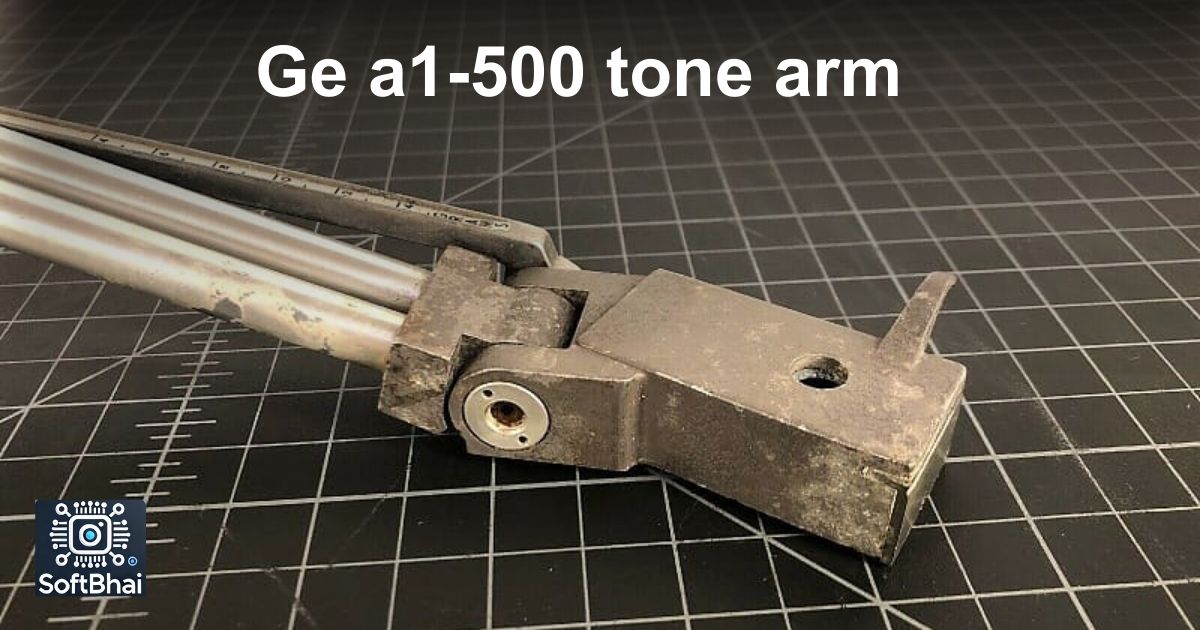In the world of vintage audio equipment, some pieces stand out not just for their age, but for their clever engineering and unique approach to common problems. The GE A1-500 tone arm is one such piece. This compact “Baton” style arm brought professional broadcasting features to home users in a surprisingly small package. Whether you’re a vinyl collector, audio enthusiast, or someone curious about vintage turntable technology, understanding what makes the A1-500 special can help you appreciate its place in audio history.
What Makes the GE A1-500 Special
The “Baton” Design Philosophy
The GE A1-500 earned its nickname “Baton” from its distinctive straight-line design. Unlike traditional curved tone arms that pivot from a single point, the A1-500 uses a sliding mechanism that keeps the cartridge at a consistent angle to the record groove. This design was revolutionary for its time and solved many tracking problems that plagued conventional arms.
Professional Broadcasting Heritage
GE designed the A1-500 primarily for radio stations and professional broadcast use. This heritage shows in its robust construction and reliable performance. Radio DJs needed equipment that could handle frequent use and provide consistent sound quality, and the A1-500 delivered on both counts.
Compact Size vs. Professional Performance
One of the most impressive aspects of the A1-500 is how much performance GE packed into such a small unit. The entire arm measures just a few inches, yet it can track records with precision that rivals much larger, more expensive systems.
Key Features and Specifications
Unique Sliding Design
The heart of the ge a1-500 tone arm lies in its parallel tracking system. Instead of pivoting like traditional arms, the cartridge slides in a straight line across the record. This eliminates tracking error that occurs when a pivoting arm creates an arc rather than following the record’s spiral groove pattern.
12-Inch Record Compatibility
Despite its compact size, the A1-500 handles full-size 12-inch LP records without any issues. The sliding mechanism provides enough travel to play from the outer edge to the inner groove smoothly and accurately.
Variable Reluctance Cartridge Optimization
The A1-500 was designed specifically for variable reluctance cartridges, which were common in professional broadcasting. These cartridges work differently from modern magnetic cartridges, requiring specific electrical characteristics that the GE arm provides perfectly.
Build Quality and Materials
GE built the A1-500 to last, using heavy-duty materials and precision manufacturing. The sliding mechanism uses quality bearings that remain smooth even after decades of use. The headshell and arm tube are made from sturdy materials that resist wear and maintain their shape over time.
Understanding the A1-500’s Unique Operation
How It Differs from Traditional Pivot Arms
Most tone arms pivot from a fixed point, creating an arc as they track across a record. This arc doesn’t match the record’s spiral groove pattern, creating tracking error. The A1-500’s straight-line movement eliminates this error entirely, resulting in more accurate groove tracking.
The Parallel Tracking Advantage
Parallel tracking means the cartridge maintains the same angle to the groove throughout the entire record. This consistent geometry reduces distortion and wear on both the record and the stylus. It’s particularly noticeable on inner grooves, where traditional arms struggle most.
Headshell Vertical Pivot System
While the main arm slides horizontally, the headshell can pivot vertically to accommodate warped records. This flexibility helps maintain proper tracking even when records aren’t perfectly flat.
Setup and Installation Guide
Mounting Requirements
The A1-500 requires a specific mounting base that allows for the sliding motion. The base must be level and stable, as any movement will affect tracking accuracy. Most original GE turntables came with the proper mounting system, but adapters exist for other turntables.
Cartridge Installation
Installing a cartridge on the A1-500 follows standard procedures, but the headshell design is unique. Make sure the cartridge is properly aligned and the stylus tracking force is set according to the cartridge manufacturer’s specifications.
Tracking Weight Adjustment
The A1-500 uses a simple counterweight system to adjust tracking force. Start with the cartridge manufacturer’s recommended tracking force and fine-tune by ear. The parallel tracking design is more forgiving of tracking force variations than traditional arms.
Anti-Skate and Balance Settings
Since the A1-500 tracks in a straight line, it doesn’t need traditional anti-skate adjustment. However, proper balance is still important. The arm should float freely when balanced correctly, neither diving toward the record nor lifting away from it.
Performance and Sound Quality
Tracking Ability
The A1-500 excels at tracking difficult passages that might cause other arms to skip or distort. Its consistent geometry and stable platform make it particularly good with damaged or worn records that might challenge conventional arms.
Sound Characteristics
Users often describe the A1-500’s sound as clean and detailed, with excellent separation between instruments. The lack of tracking error contributes to a more accurate reproduction of the original recording, especially on inner grooves where the benefits are most noticeable.
Comparison with Modern Arms
While modern tone arms have advantages in materials and manufacturing precision, the A1-500’s parallel tracking principle remains sound. Many current high-end arms use similar straight-line tracking, proving that GE’s 1950s design was ahead of its time.
Maintenance and Care Tips
Regular Cleaning Procedures
Keep the sliding mechanism clean and lightly lubricated. Use a soft brush to remove dust and debris from the tracks. Avoid harsh solvents that might damage the bearings or finish.
Common Issues and Solutions
The most common problem with A1-500 arms is sluggish movement in the sliding mechanism. This usually comes from dried lubricant or accumulated dirt. Careful cleaning and re-lubrication typically solves the issue.
Replacement Parts Availability
Original GE parts are becoming scarce, but some specialty audio restoration services can rebuild or repair A1-500 arms. The robust design means many arms still work well with minimal maintenance.
Is the GE A1-500 Right for You?
Best Use Cases
The A1-500 works best for listeners who appreciate vintage equipment and want to experience the benefits of parallel tracking. It’s particularly good for playing older records that might have tracking challenges.
Limitations to Consider
The A1-500 requires specific cartridges and careful setup. It’s not as plug-and-play as modern equipment. Also, finding replacement parts can be challenging if repairs are needed.
Modern Alternatives
Several current manufacturers make parallel tracking arms, though they’re typically much more expensive than the original A1-500. For those wanting similar benefits with modern convenience, these newer designs might be worth considering.
Conclusion
The GE A1-500 tone arm represents a clever solution to the fundamental problems of record playback. Its parallel tracking design eliminates tracking error while maintaining the simplicity and reliability needed for professional use. While it may not have all the conveniences of modern equipment, the A1-500 offers a unique listening experience that many audio enthusiasts still cherish today. Whether you’re exploring vintage audio gear or looking for an alternative to conventional tone arms, the A1-500 demonstrates that good engineering principles remain relevant regardless of age.

